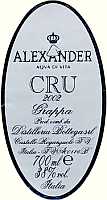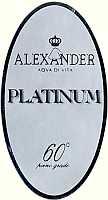
Wine Culture and Information since 2002 - Volume 22
 Wine Culture and Information since 2002 - Volume 22 |
|
GarlicProbably coming from the Middle East, very used in cooking both raw and cooked to seasoning foods, appreciated as a remedy as well as for its preventive properties against many diseases |
|
Garlic is a plant having countless beneficial properties, considered by ancient Egyptians as a god. Both used as a food and as a remedy, it is traditionally an indispensable ingredient of the cooking in every country of the world as well as a remedy for the body. Allium sativum belongs to the liliaceae family, it is a perennial herbaceous plant with a bulb containing cloves, that is the part mainly used. Leaves are attached to the base, about one centimeter wide getting thinner towards the tip. Flowers, gathered to the top of the plant, are closed, before blossoming, in a bract covering the whole flower and are made of six whitish colored petals. Sometimes in flowers are also found small bulbs and as they fall on the ground - provided they also find a proper environment - may give origin to new plants. The plant of garlic does not grow wild and it is cultivated in every tempered area of the world, industrially produced because of its wide use in cooking. There are many varieties: some having bulbs with a white colored skin, called common garlic, other with a pink or mallow colored skin, known as red garlic. Bulbs can be of many sizes, as well as the size and the number of cloves contained in them. The aroma changes according the variety and the climate: there are varieties of garlic with sweet and delicate taste with an aroma similar to walnuts; other are strong with a pungent aroma. The best garlic comes from warm climate countries. Garlic is not a very demanding plant: its cultivation requires a rich, light and well drained soil and plenty of sun.
|
|
Garlic probably comes from the Middle East, known and appreciated since the ancient times, both as an ingredient to season foods and sauces, as well as a remedy. It was used by Chinese, Babylonians, Arabs and Egyptians. Hebrews walking towards the promise land, missed Egyptian garlic. The most ancient written evidences about garlic are in Sanskrit language, where it was defined as “the killer of monsters”, even though the first useful information are found in an Egyptian papyrus - the Codex Ebers dated back to 1550 BC - about twenty meters long and containing hundreds of medical prescriptions. Garlic is mentioned in about twenty prescriptions mainly as a remedy against insect stings, to relief headache and as a relief for pain. In Egypt garlic was considered as a sacred plant and was given to slaves involved in hard works in order to improve their stamina.
In the tomb of Egyptian pharaoh Tutankhamen have been found bulbs of garlic probably left there in order to keep away evil ghosts. The medical knowledge of the Egyptian tradition was assimilated by Greeks, who filtered all the magic formulas while keeping the practical parts only, that is the medical prescriptions, the preparations and the techniques. Hippocrates, one of the greatest physicians of ancient times, based his theories by observing facts and recommended the use of garlic for its medical qualities, guaranteed by the Egyptian tradition and popular experience. Greek athletes consumed garlic before competitions. During the times of Roman Empire, and precisely in the first century before Christ, Roman legionaries used garlic as a remedy against infections and vermifuge, likewise Gauls ate garlic before fights. In ancient Rome the Latin expression allium olere (stinking of garlic) was used to refer to people belonging to a lower social class. Pliny the Elder in his Naturalis Historia, taught with detailed prescription about the many therapeutic uses of garlic. Other ancient authors mentioned the properties of garlic, including Ovid, Herodotus, Terence and Varro. According to a legend, during the epidemic of pestilence in Europe around the fourteenth century, only frequent garlic consumers were saved from the contagion. An important reference point in history is mentioned in a manuscript of the sixteenth century, known as “Erbario di Urbino” (Urbino's Herbarium), in which is found an excellent collection of empirical knowledge and popular traditional medicine about the therapeutic properties of plants. So far all the documents are based on or mention traditions, superstitions and popular beliefs. A popular tradition has it that a tuft of garlic in every house offers protection against evil ghosts. During renaissance, garlic was kept away and even banned from the tables of noble people, because of the bad smell it gave to breath, to sweat and intestinal gases. The first scientific information - in the way we recognize them today - are dated back to 1858. Louis Pasteur, important French figure in the history of chemistry thanks to the process of pasteurization and of medicine for his researches about microbes, scientifically determined the antibiotic qualities of garlic. Albert Schweitzer, the famous organ player, Nobel prize and physician, has spent many years of his life to cure the least lucky people of Africa: he used garlic as a remedy for dysentery and against tuberculosis, typhus and diphtheria. In China, where garlic is consumed by at least three thousand years, are being conducted some researches about its medical properties in the province of Shandong, where the local people - since a very long time - are big garlic consumers. It seems that eating this plant as well as other liliaceae, contributes to lower the risk of cancers.
|
||||||||
|
Before listing the beneficial and medical properties of garlic, it is good to remember that when plants, vegetables and fruits are mentioned, most of the times are emphasized their beneficial and therapeutic properties for the body. It is good to remember these benefits are not to be considered as real medicines. Therefore, by saying garlic is good against hypertension, this does not mean it must be used instead of the pills prescribed by the doctor, it means a regular consumption helps to relief this problem. By considering pharmaceutical industry is very attentive to the research of a “truly working” active substance, in case it was discovered it would certainly be started its industrial production, in case the product does not contain active substances in relevant quantities, but only at a level of “coadjuvant”, it is ignored and relegated to the group of food integrators. The best quality garlic is hard, with cloves joined together to the cartilaginous membrane with no uncolored stains. In case some cloves with uncolored stains are found - this may happen in some seasons - it is better to eliminate them with a knife as the taste in this spots is bad and can easily ruin any preparation. Garlic is famous for its unmistakable aroma, because of a substance contained in its bulbs. As the clove is cut, this substance gets combined with an enzyme therefore giving origin to its characteristic aroma. Garlic is an efficient antiseptic and improve the resistance of the body against infections. Garlic helps to alleviate atherosclerosis, diabetes and all the pathologies in which are involved free radicals. Ayurvedic medicine considers garlic a good remedy against leprosy. Garlic juice is rich in potassium, therefore it helps to keep blood pressure low. Popular tradition believes garlic is useful as a remedy for cholesterol, triglycerides, dysentery, constipation, diabetes, tracheitis, pharyngitis, tonsillitis, asthma, cold, sinusitis, catarrh, cysts and insect stings. In ancient times is was used - as a remedy for rheumatism - the vinegar of four thieves, obtained by macerating garlic and thyme in vinegar. In order to make garlic more digestible, as well as keeping almost unaltered its fragrance, it is good to cut the clove along its longest side and to completely remove the central part. Moreover, it seems that chewing some leaves of parsley helps to eliminate the bad smell of the breath after having eaten garlic. Garlic is not a panacea and it should not be consumed by anyone as it has some contraindications. Garlic must not be consumed in case of gastritis, stomach and duodenal ulcers, excess of acidity - because of its stimulating effect on the secretion of gastric juices - in case of pregnancy or breast feeding, irritations of the stomach and bowl, gastric irritations, hypotension and diseases of the skin. Raw garlic is found worldwide in many cooking recipes such as garlic butter, garlic oil, aïoli - a characteristic sauce from southern France and Spain - Skordalia - characteristic in Greece - and the renowned pesto alla Genovese. Garlic is also used in the cooking of European countries, in the Middle and Far East, in Africa, India, North and South America. It certainly is easier to list the recipes in which garlic is not found instead of the ones in which it is used. Its taste is well amalgamated with every type of meat, game, fish, crustaceans, mushrooms and most of vegetables. Some use garlic with mushrooms in order to enhance aromas. Garlic - besides onion - is one of the most used ingredients found in every cooking culture of the world.
|
||||
|
The nutritional contribution of garlic in human feeding is not significative, mainly because it is usually consumed in small quantities. According to a nutritional point of view, 100 grams of garlic contain: 41 KCal, of which 9% proteins, 13% fats and 78% carbohydrates. The chemical composition contains 80 g of water, 0.9 g proteins, 8.4 g carbohydrates, 0.6 g fats, 3.1 g fibers and 0 g cholesterol. Vitamins contained in garlic are A, B1, B2, B3, C and E. The content in mineral is 1.5 mg iron, 14 mg calcium, 63 mg phosphor, 600 mg potassium.
|
AquavitaeReview of Grappa, Distillates and Brandy |
|
|
| Distillates are rated according to DiWineTaste's evaluation method. Please see score legend in the "Wines of the Month" section. |

|
|
Nonnu 'Elogu Bianca |
|
| Giovanni Cherchi (Italy) | |
| (Distiller: Distillerie Berta) | |
| Raw matter: Pomace of Vermentino Tuvaoes | |
| Price: € 14.50 - 50cl | Score: |
| This grappa is colorless, limpid and crystalline. The nose denotes intense, clean and pleasing aromas of pear, raspberry, broom and hazelnut, almost imperceptible alcohol pungency. In the mouth is intense with alcohol pungency which tends to dissolve rapidly, perceptible sweet taste. The finish is persistent with flavors of pear, raspberry and a sweet hint. Alcohol 40%. | |

|
|
Nonnu 'Elogu Ambrata |
|
| Giovanni Cherchi (Italy) | |
| (Distiller: Distillerie Berta) | |
| Raw matter: Pomace of Cagnulari and Cannonau | |
| Price: € 14.50 - 50cl | Score: |
| This grappa shows a brilliant amber yellow color, limpid and crystalline. The nose reveals intense and clean aromas of praline, plum, vanilla, licorice, blueberry and banana. In the mouth is intense and agreeable with alcohol pungency that tends to dissolve rapidly, agreeable sweet hint. The finish is persistent with flavors of praline, licorice and banana. This grappa ages in cask. Alcohol 40%. | |

|
|
Grappa Alexander Cru 2002 |
|
| Distilleria Bottega (Italy) | |
| Raw matter: Pomace of Prosecco and Muscat | |
| Price: € 14.73 - 70cl | Score: |
| This grappa is colorless, limpid and crystalline. The nose reveals intense, clean and pleasing aromas of walnut, banana, pear, plum, broom, raspberry, black cherry, hay, hazelnut, lavender and white melon with almost imperceptible alcohol pungency. In the mouth is intense with immediate perception of alcohol even though tends to dissolve rapidly, well balanced sweet hint. The finish is persistent with flavors of walnut, pear and hazelnut. A well made grappa distilled in steam operated alembics. Alcohol 60%. | |

|
|
Grappa Alexander Platinum |
|
| Distilleria Bottega (Italy) | |
| Raw matter: Pomace of Amarone and Recioto (Corvina, Rondinella, Molinara) | |
| Price: € 19,50 - 70cl | Score: |
| This grappa is colorless, limpid and crystalline. The nose reveals intense, clean and pleasing aromas of walnut, banana, pear, plum, broom, raspberry, black cherry, hay, hazelnut, lavender and white melon with almost imperceptible alcohol pungency. In the mouth is intense with immediate perception of alcohol even though tends to dissolve rapidly, well balanced sweet hint. The finish is persistent with flavors of walnut, pear and hazelnut. A well made grappa distilled in steam operated alembics. Alcohol 60%. | |
Wine Parade |
|
|
| The best 15 wines according to DiWineTaste's readers. To express your best three wines send us an E-mail or fill in the form available at our WEB site. |
| Rank | Wine, Producer | |
|---|---|---|
| 1 |
| Harmonium 2001, Firriato (Italy) |
| 2 |
| Montepulciano d'Abruzzo Villa Gemma 1999, Masciarelli (Italy) |
| 3 |
| Riesling Cuvée Frédéric Emile 1999, Maison Trimbach (France) |
| 4 |
| Pinot Noir Napa 2002, Clos du Val (USA) |
| 5 |
| Turriga 1998, Argiolas (Italy) |
| 6 |
| Chablis Grand Cru Les Clos 2002, Domaine Billaud-Simon (France) |
| 7 |
| Amarone della Valpolicella Classico Capitel Monte Olmi 1999, Tedeschi (Italy) |
| 8 |
| Brunello di Montalcino Prime Donne 1998, Donatella Cinelli Colombini (Italy) |
| 9 |
| Jerez Fino Tio Pepe, Gonzalez Byass (Spain) |
| 10 |
| Moscato d'Asti 2003, Vignaioli di S. Stefano (Italy) |
| 11 |
| Palazzo della Torre 2000, Allegrini (Italy) |
| 12 |
| Notarpanaro 1999, Taurino (Italy) |
| 13 |
| Barolo Cicala 1999, Poderi Aldo Conterno (Italy) |
| 14 |
| Edizione Cinque Autoctoni 2001, Farnese (Italy) |
| 13 |
| Montepulciano d'Abruzzo Riparosso 2001, Illuminati (France) |
|
||||||||
|
DiWineTaste Polls
|
| |||||||
Privacy Policy | |||||||


| Copyright © 2002-2024 Antonello Biancalana, DiWineTaste - All rights reserved |
| All rights reserved under international copyright conventions. No part of this publication and of this WEB site may be
reproduced or utilized in any form or by any means, electronic or mechanical, without permission in writing from DiWineTaste. |